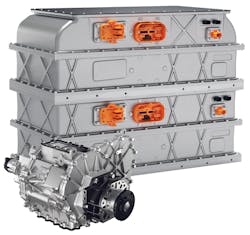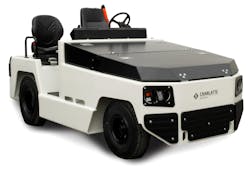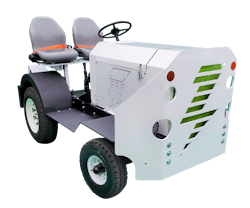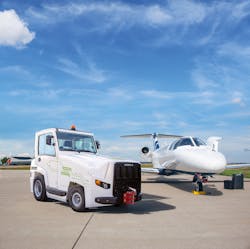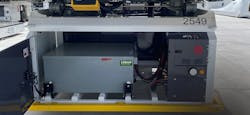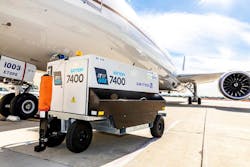The FAA recently awarded more than $20 million in grants to reduce emissions and improve air quality at airports across the country.
The awards are intended to fund zero-emission airport vehicles as well as electric charging infrastructure and aim to electrify ground support equipment (GSE).
This funding is among the latest initiatives prompting the adoption of electric ground support equipment (eGSE). Environmental goals established by governments, industry organizations, airports, airlines and individual ground service providers are also lending themselves to eGSE.
With a focus on reducing ground emissions on the ramp, many manufacturers across the market are finding solutions to benefit the GSE industry.
PCS Integrates GM Drivetrains for GSE
Years ago, Powertrain Control Solutions (PCS) found its way to the ground support equipment industry by integrating automotive technology from General Motors (GM) into existing GSE.
PCS has recently waded into the eGSE market with a similar project, converting GSE by adapting the GM electric vehicle drivetrain into airport equipment.
“Our original introduction to the ground support market used a transmission that GM released to the automotive world,” PCS president Dan Boucher recalls. “We customized it and integrated it with the performance and safety features that the ground support world needed.
“With what we’ve done to that, it’s been a success in the industry. We’re doing the same exact thing, just now with an electric driveline.”
PCS debuted its eGSE solution at the International GSE Expo, which is comprised of an electric motor and battery pack produced by GM. The customized version of GM’s powertrain has been built into several GSE units, including a belt-loader, an M1A bag tractor and an MA bag tractor.
“For more than 60 years, GM’s OEM sales business, now GM Powered Solutions, has provided engines, transmissions and other propulsion equipment to companies in marine, industrial, off/on highway and utility markets,” says Tony Brower, GM’s senior manager of OEM sales and engineering. “This strategic collaboration represents an exciting opportunity for GM to extend its commitment to an all-electric future into other industries, enabling companies that utilize ground support equipment to reach their own emissions targets.”
While this project got a head start by utilizing existing electric vehicle technology, PCS had to find a way to get the battery system to fit into GSE units. Engineers reconfigured the layout of GM’s lithium-ion powered cell module assemblies (CMAs) to fit within the footprint provided by a bag tractor or belt-loader.
“The new battery created for the ground support industry uses two production CMAs stacked on top of each other” Boucher says. “It has all the safety features, all of the performance, all of the advanced manufacturing that goes into it.”
PCS engineers customized the motor that’s used in GM’s on-highway vehicles with a component used on all PCS transmissions designed for the GSE industry. According to Boucher, this creates a drop-in solution for customers converting from an internal combustion engine and transmission and allows customers to use the same driveshaft, shifter and parking brake.
“We really tried to make a driveline that would look as common as what they’re using now. But you have all the benefits of the electric drivetrain over the internal combustion engine,” Boucher says. “To the operator, it doesn’t look any different. They know how to operate it. They’re comfortable with it.”
Partnering with GM on this project, allowed for extensive testing of the bag tractors at the automotive manufacturer’s testing facility in Milford, Mich.
“It was a very significant integration project. The testing and the validation was incredibly significant,” Boucher says.
GM’s electric vehicle technology provides charging flexibility.
“These can take as little as 110 or 120V AC charging. It’s slow, but it’s available everywhere,” Boucher says.
“Stepping that up, you can use 240 or 208V and get about 10 percent per hour,” he adds. “Then you still have the option of a Level 3, which is a dedicated high-speed charger on operations that need it.”
The vehicles use the same SAE charging receptacles that electric vehicles use, so no custom charging equipment is required.
“The batteries are also designed to be more than a battery,” Boucher says.
“On many electric GSE vehicles, you have a battery and some high-voltage wiring that goes to the main contactors somewhere on the vehicle,” he explains. “On the on-highway batteries, the main contactors are built inside the pack itself. So, you don’t have any high-voltage wiring containing high-voltage, unless the system has identified that everything is safe to close the contactors and turn on the high-voltage.”
With constant monitoring of different interlock loops and a fireman safety loop, similar to what’s found on on-road electric vehicles, several safety features have been designed to reduce the risk of high-voltage accidents. A battery management system contained inside the pack and another one outside the pack constantly monitors cell voltage, current and state-of-charge to make sure everything is operating within safe limits.
“If there are any issues, it will not allow any systems to engage the high-voltage,” Boucher says.
Because the motor used in these bag tractors and belt-loader provides 200 hp, there are plans to expand the use of the electric drivetrain.
“What we’re anticipating is that this one driveline will really be able to scale across an entire fleet of GSE for a particular airline. They will be able to use this driveline in bag tractors, cargo tractors, pushbacks, catering trucks, lav trucks because it so scalable and so configurable,” Boucher says. “We started with the small equipment, but it’s very scalable, so the next steps for us is to move into the larger equipment.”
Charlatte’s Efforts to Electrify Cargo
As operator comfort and confidence in electric GSE has grown, officials at Charlatte saw an opportunity to serve the cargo handling industry. As a result, Charlatte recently designed and rolled out it 6,000-DBP electric cargo tractor, known as the CT6E.
Company officials note the goal of this project is to provide the industry with an alternative to internal combustion vehicles when hauling heavy cargo long distances.
The CT6E can tow heavier loads throughout the day because the frequency of charge-time is reduced, which allows the vehicle to operate for a period of almost 50 percent longer because of the large 840Ah lithium battery, according to Charlatte officials.
“The vehicle is just being introduced to the North American market,” says Rob Lamb, vice president – vehicle and aftermarket sales at Charlatte, noting it debuted at the International GSE Expo in Las Vegas. “However, being patient and doing an abundance of testing as well as receiving customer input along the way in the design process makes us more than optimistic for its success.
Charlatte officials have utilized common parts, including axles, motors and several of the main electronic components as its T135, T137 and CT5E models, making training and vehicle operations easier for existing customers.
According to Lamb, there has been a need for this type of cargo tractor for some time. He says more ground handlers servicing passenger airlines have become comfortable with electric GSE, having seen improved performance, cost-savings and safety benefits. So, developing an eGSE solution for the cargo sector is a logical step.
“Providing a solution to the cargo industry furthers the reduction of emissions, is more operator friendly and saves money by improving performance,” Lamb says.
“Companies are tired of using LPG tractors, forklifts and smaller electric-style mules inside their cargo facilities,” he continues. “Now they can maximize their efficiencies and give the operator a more comfortable and safer vehicle to operate, like the workforce in the bag rooms of passenger airlines have been doing for years with our other electric models.”
Although some companies postponed new vehicle projects during the pandemic, Charlatte used that time to focus on the future. Charlatte’s engineering teams in the U.S. and in Europe spent months developing the CT6E and worked closely with Green Cubes Technology to finalize specific details.
For example, Lamb says selecting the shape, size and weight of the battery compartment, as well as the compartment itself, for such a large lithium battery while keeping the footprint of the tractor constant was challenging.
“There are several factors in selecting a battery to not only operate at its highest performance in conjunction with the electronic controller, but also to provide proper / adequate ballast for the cargo tractor to operate at its maximum capacity,” he adds.
Having overcome these challenges, Charlatte officials are encouraging the industry to trial the vehicle to realize its ability to make long cargo runs with heavy loads. If tests are successful, Lamb says the company will consider building a family of rear-cab design cargo tractors in a higher towing range to complement the CT6E.
A&V’s Lithium Solution for Ground Handling
When Menzies Aviation was looking for help in reducing emissions within their operations teams based in the U.S., the ground service provider looked for ways to convert is fleet of baggage tractors and belt-loaders to an electric powertrain.
A&V Rebuilding was able to provide up-cycled lithium electric powered baggage tractors and belt-loaders with a fully integrated battery management system (BMS) and additional safety features.
“Not only are these units allowing us to move closer to our aim to be carbon neutral by 2033, Menzies’ 200th anniversary, the advanced safety features of both the belt-loaders and the baggage tractors will ensure a safer work environment for our employees,” says Scott Bellamy, director of GSE-Americas for Menzies Aviation.
When approaching the project, A&V relied on its history of building internal combustion engine (ICE) powered remanufactured GSE and expanded on it with the new Lithium technology.
“We have known for many years that there was a need for electric baggage and cargo tractors that could be used as effectively as their internal combustion engine counterparts,” explains Gerry Hoadley, owner of A&V Rebuilding.
“We were one of the first to develop a lithium power package to replace the ICE engine in a baggage tractor back in 2011,” he continues. “Our early development was ahead of its time and unaffordable due to the very high cost of lithium batteries at that time.”
After early attempts at converting GSE to lithium power, the project was revisited when Chris Shaeffer of Airport Terminal Services (ATS) approached A&V about developing a repowered baggage tractor with a lithium electric drive system. This initiative ultimately led to A&V’s partnership with LevCon to deliver an electric drive system that is now in use by Menzies.
The LevCon package has been well received, prompting A&V to expand its use. Now through its subsidiary, AV GSE, the LevCon package is also being utilized by Taylor-Dunn to power its redesigned Tiger TC series of baggage and cargo tractors.
“Like other A&V electric equipment, the new lithium electric powered Tiger TC series tractors are equipped with the LevCon drive system and feature their patented anti-rollover safety feature,” Hoadley explains.
Officials at A&V were working on ATS’s eGSE project prior to the pandemic. But as business slowed down, more focus could be directed to building prototypes and performing tests.
“In all honesty, the pandemic was a big help,” Hoadley recalls. “We worked nearly two years developing and testing our tractor package. After thorough in-house testing, we enlisted the help of our customers for on airfield testing.”
ATS was the first company to test the tractor on the ramp, using it in daily operations at John Wayne Airport (SNA) in Santa Ana, Calif., alongside its existing fleet of eGSE.
“Most of their ramp agents liked it because it was more of a traditional tractor like they were used to, where you sat up high on the tractor and you could see everything,” Hoadley says.
Menzies became A&V’s second testing partner. After placing an order for the lithium baggage tractors to be used at Ontario International Airport (ONT), A&V sent the ground handler a lithium repowered belt-loader equipped with its Plane-Safe Collision Deterrent system for testing.
“They promptly ordered two of these for ONT as well,” Hoadley notes, adding the units run-time offered advantages. “We have now sold Menzies lithium powered equipment for multiple stations and are working with them to hopefully supply many more.”
The LevCon solution fits within the footprint of existing tractors with minimal modification. Being able to utilize the existing steel and other materials of the tractor itself has environmental benefits, too.
“The fact that these units are built around refurbished chassis means less materials are ending up at landfills,” Bellamy notes.
In addition to emission benefits, a reduction in fuel and maintenance costs can also be achieved.
“Other than an occasional gear oil replacement in the drive axle, and basic lubrication, there is very little to service. Even brake pads last longer due to our programmable regenerative braking system that uses the AC induction motor to do most of the stopping,” he says.
Hoadley says modern LiFePO4 batteries are forecasted to last 10-12 years, or more, with proper charging.
“The biggest challenge anyone faces when thinking of going electric is the charging infrastructure,” Hoadley explains, noting his equipment can be charged multiple ways.
“If the customer has access to fast chargers with communication pins, we can supply the equipment with the necessary battery identifier modules to communicate with their chargers,” he continues. “For customers without charger infrastructure available, our equipment can be fitted with on-board chargers that can charge using a 110v or 220v outlet. This type of charging is done through a J1772 charge connector and an EVSE equipped power cable. We have also developed a charge cart, which can charge our equipment using 400hz aircraft bridge power or a GPU if necessary.”
Hoadley credits working with people familiar with the ramp environment to gather input during the development stage. As a result, he says feedback has been positive. Specifically, he says one ramp manager raved about the Plane-Safe Collision Deterrence technology and the peace of mind that comes with knowing operators cannot accidentally collide with aircraft.
A&V plans to work with LevCon to increase the lithium repower package offerings for the GSE industry. In addition to working with Taylor-Dunn on its Tiger tractors, plans to move into larger types of GSE are also on the horizon.
Webasto and Goldhofer’s eGSE Partnership
As Goldhofer began ramping up its efforts to electrify its ground support equipment offerings, including the Sherpa E New Gen, Webasto offered its support by supplying batteries for the vehicles as well as training and technical support.
Goldhofer officials note the advantages of an electrically powered cargo tractor include no CO2 emissions, lower noise and zero particulate pollution among others. What’s more, eGSE requires less maintenance.
“An airport, by the way, is a great environment for electric vehicles, as they are not required to cover long distances and constantly pass by the charging station. It is our assumption that electrified ground support equipment at airports will rise above their niche status,” adds Jochen Preßmar, senior project engineering manager for electric vehicles at Goldhofer.
With many airports declaring goals to reduce ground emissions, Webasto and Goldhofer have partnered to optimized Goldhofer’s cargo and pushback tow tractor, the Sherpa E New Gen. Introduced in 2017, the Sherpa E offers quiet and emission-free operation. With an intelligent charging infrastructure, it offers additional benefits.
Besides an expanded performance range and extended service life, the enhanced version can be charged more quickly and with greater flexibility and provides for longer maintenance cycles and lower operating costs. The new model now comes with a gearless direct drive that generates a torque of up to 1,050 Nm. It is powered by a modular battery system with intelligent temperature management.
Several factors prompted Goldhofer to turn to Webasto to supply the battery power necessary to operate the Sherpa E.
“Imposing exacting requirements and placing prime importance on the quality and longevity of our vehicles, we take great care to only use components that offer great promise and that allow us to maintain our high standard of quality,” Preßmar says.
“Depending on the version and in line with the customer’s specific requirements, we equip the Sherpa E with one or two Webasto batteries, each generating 35 kWh,” he adds.
Webasto’s battery solution has been subjected to electromagnetic compatibility testing and therefore does not interfere with radio or electronic components. Additionally, the modular design of the battery system allowed Goldhofer to use the power source across multiple types of GSE units.
“We have diverse vehicle ranges of different sizes and requirement levels. We identified Webasto as an all-rounder for the Sherpa and Bison product segment, which offers us as a company the option of modular construction,” says Rüdiger Dube, head of product management airport technology at Goldhofer.
Goldhofer currently utilizes lithium-nickel-manganese-cobalt-oxide batteries. Company officials note the energy density provided by these units is ideally suited for their applications.
“It is our hope that energy density on the cell level will keep increasing in the future,” adds Preßmar.
Goldhofer is currently aiming for at least eight years of battery life from the current units. After that time, Webasto officials note the battery should still deliver significantly more than two-thirds of its original output capacity.
“It remains to be seen if the customer will actually switch batteries or merely opt to make slight variations to their cycle,” notes Preßmar.
“However, when a battery doesn’t have its original capacity anymore, does that mean the battery is ready to be discarded? No, it still can be used, but serving a different purpose in a second-life application, e.g. as a stationary or mobile buffer storage battery,” adds Dube.
When it comes to the service life of the battery, it will be necessary to gain more experience and perform additional analyses. Experience and evaluations will also play a role in the integration of the batteries in future projects. The mechanical integration plus coolant supply and high-voltage connection were successfully integrated into the Sherpa E.
Webasto assisted Goldhofer throughout the development process. The companies exchanged data collected during the trial phase and continued to meet on a regular basis.
Calling the trend toward zero-emission drive systems highly dynamic and irreversible, Webasto and Goldhofer intend to continue supporting airports on their way to achieving zero emissions.
“We are very pleased to have gained a strong and experienced partner in Goldhofer, with whom we can drive forward electrification in the field of ground support equipment, thereby making our contribution to achieving emission-free airports around the world,” says Michael Bauer, vice president business line energy management at Webasto. “In order to be able to meet the ever-increasing demands on electric ground support vehicles we will continue to offer, and constantly expand, a comprehensive portfolio of solutions for electric vehicles. As a driver of electromobility, Goldhofer plays a key role in stimulating us to develop future products for electric vehicles in the airport sector that meet market requirements as closely as possible.”
Green Cubes Technology’s IoT Solution for eGSE
In a connected, digital world, using relevant data is key to success. Green Cubes Technology has more than 5,000 lithium batteries deployed with customers and those users were looking for data on the usage of the batteries in their fleet.
“This data is very important for small and enterprise fleet managers alike. When eGSE started to gain popularity, a demo or power study helped fleet managers make decisions about what size battery to deploy in their operation,” says Jerry Crump, director of business development – GSE at Green Cubes Technology. “This became the norm.”
That demand for data prompted Green Cubes Technology to create Maestro IoT, an Internet of Things (IoT) technology solution for the GSE market.
“We have developed a cloud-based telematic system, Maestro IoT, for our batteries that allows our customers to review their battery fleet’s performance from a high level all the way down to the individual battery,” Crump explains. “This includes data on battery location, enterprise wide, battery status, current and voltage, throughput, charge and discharge cycles, battery runtime and many other metrics.
“The data reporting can be customized for specific needs,” he adds. “This system is now in use with multiple customers that review and track their batteries daily.”
Using a cloud-based system allowed Green Cubes Technology officials to overcome the project’s biggest challenge – how to receive the data. Green Cubes Technology representatives solicited helpful feedback about connectivity issues brought on by firewalls and determined alternative connectivity methods for customers.
“With internet security a concern, it can be challenging to access the ports in a firewall to put a system online. With a cloud-based system, strong and safe internet connectivity is required to display the collected data,” Crump says. “Green Cubes Technology offers alternative set-up methods of data transmission by using cellular modems to provide alternative Wi-Fi transmission, or sim cards to transmit independent of a Wi-Fi network.”
A system with telematics allows fleet managers to see data on how their equipment is performing. This information allows for making informed purchasing decisions for battery sizing, fleet sizing and common infrastructure issues, such as proper charging capabilities.
“Our IoT technology gives fleet managers the ability to capture months of operational data that is housed on a cloud server, and can be exported to evaluate trends, and operational changes based on time of year, or peak seasons,” Crump says.
This same technology could be rolled out to other platforms down the road, or even integrated with fleet management software through exports if the company's customer base saw value in this type of integration, according to Crump.
In the meantime, Green Cubes Technology officials continue to fine tune the solution to best suit specific customer needs.
“In our experience, we’ve found it’s important to always keep in mind operational constraints at each individual customer location,” Crump says. “A one-size-fits-all solution approach to capturing data at our very diverse customer locations will not work.”
Reduced Ramp Emissions with ITW eGPUs
At Los Angeles International Airport (LAX), maintenance personnel at United Airlines found they were performing extensive “outside of hangar” maintenance activities on the ramp area. With no electrical infrastructure in place, the airline’s technicians were left with the choice of using mobile diesel ground power units (GPUs).
With a need to meet existing Environmental Protection Agency (EPA) requirements in California – as well as Texas, United Airlines turned to ITW GSE’s 7400 electric ground power units (eGPU), which can be charged nearly anywhere an electrical circuit is available and deliver a power source to remote areas for use.
“In California and Texas, ‘fossil fueled’ GPUs had been targeted due to their extended run-times and overall use in remote aircraft staging locations, explains Andrew Alexander, senior manager – facilities and GSE engineering at United Airlines. “Replacing these fossil fueled GPUs with environmentally compliant equipment was the overall goal. Based on the performance of the ITW 7400 series lithium-ion powered GPUs, United Airlines has now adopted this GPU replacement strategy wherever possible.”
At legacy airports, infrastructure power can often be an issue at many gates. However, a relatively small electrical circuit allows the 7400 to be used when there are no spare electrical circuits available for standard electrically powered fixed GPUs.
“Infrastructure support for charging the ITW 7400 equipment has been a challenge,” notes Alexander. “Through the partnership with ITW and several airport authorities, charging infrastructure has been installed.
“In addition to the infrastructure challenges mentioned, ITW, in partnership with Crescent Electrical Supply, has developed a viable ‘Powershare’ option using existing power from a jet bridge circuit. This development reduces overall infrastructure costs and provides United operations the ability to charge the 7400 series unit at a gate or terminal location.”
According to Alexander, the 7400 eGPU offers a similar boost in environmental-related compliance to that of electric tractors and belt-loaders. United has also achieved fuel savings and reduced maintenance costs.
“Besides the large-scale issues regarding environmental footprint, reducing fossil fuel burning GSE has an immediate benefit regarding passenger cabin air quality,” adds Tim Fox, facilities engineering and maintenance projects and programs manager at United Airlines.
“The forced supply air ventilating the cabin, while aircraft are on the ground, originates in the ramp environment near the aircraft,” he continues. “By using electric GSE like the 7400, it helps keep the ramp environment cleaner, and therefore keeps the cabin environment cleaner.”
Serving as ITW’s launch customer in 2018, United Airline personnel have reported positive feedback on the 7400. Users have been impressed with how long available power can last from a single full charge.
According to Alexander, United is working on multiple grant opportunities and possible pay-per-use concepts for this type of equipment. As with any new technology, Alexander encourages others to not focus on negatives or costs, but rather embrace new technology and seek ways to expand on it.
About the Author
Josh Smith
Editor
Josh Smith served as editor of Ground Support Worldwide as editor from 2016 through 2024. He oversaw production of the print magazine, created GSW's newsletters on a daily basis, and updated the latest news on AviationPros.com.

